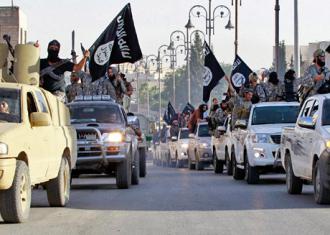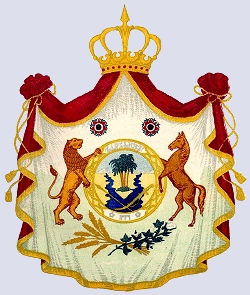Apocalypticism and the Islamic State
November 17, 2015
The Islamic State (IS) was never a part of the legitimate resistance against Syrian President Bashar al Assad. There are possibly hundreds of opposition groups inside Syria. Several of these groups consider themselves to be the leader of the rebellion. These groups are not part of a larger monolithic whole; rather, they are divergent ethnic and religious groups that are often antagonistic and even violent towards one another.
The Islamic State has used the chaos created by the Syrian rebellion to try and fulfill an obscure Islamic prophecy. Back during the zenith of Osama bin Laden’s war with the West, some Islamists started focusing on any Islamic teachings, no matter how obscure, that promoted a jihadist vision that would be global in scope. Their goal was to legitimize their politicized version of Islam and to cement the legitimacy of jihad in the minds of Muslim moderates. This search led to scholarship regarding something called Yawm ad-Din, the Day of Judgement.
that would be global in scope. Their goal was to legitimize their politicized version of Islam and to cement the legitimacy of jihad in the minds of Muslim moderates. This search led to scholarship regarding something called Yawm ad-Din, the Day of Judgement.
Eschatology is a part of theology concerned with the final events in history. Such a concept is often referred to as “end times” and it is definitely not limited to Islam. Christianity, Judaism, Buddhism, Hinduism, Baha’i, and new religious movements such as New Age religions also have eschatological theology and followers who believe in imminent apocalypticism
The Day of Judgement was first introduced to jihadi groups by the world’s foremost jihadist scholar, a Palestinian man named Abu Muhammad al Maqdisi. Maqdisi’s prominence and knowledge has attracted jihadi acolytes over the years including Abu Mus’ab al Zarqawi. Al Qaeda in the Arabian Peninsula (AQAP) called upon Maqdisi to find out if their jihad in Yemen would lead to an Islamic Caliphate. Maqdisi affirmed an exceptional destiny for the jihadists in Yemen, but added a caveat that the group in Yemen would have to go on to Syria to fulfill their destiny. Maqdisi explained that AQAP would help bring about Allah’s judgment by helping to usher in the end of the world. Maqdisi explained that jihadists in the AQAP would help mobilize popular support against the West and its apostate allies by launching attacks all over the globe. But first, the fighters in Yemen had to get to Syria.
Yemeni fighters poured into Syria, but the original al Qaeda and its affiliate the Islamic State of Iraq would play a part in popularizing Syria’s role in bringing about the Day of Judgement.
Abu Bakr al Baghdadi assumed control of the Islamic State of Iraq in 2010. Baghdadi’s closest aide, Hajji Bakr, who has been described as the “prince of the shadows,” helped his leader consolidate power. He proclaimed Baghdadi as a legitimate caliph that was helping to usher in the apocalypse. Baghdadi’s followers believe there will only be four more caliphs after Baghdadi before the end of the world.
During this period, Bakr saw jihad in pragmatic terms. He wanted to attack government troops and police as a blueprint to open up power vacuums to deplete security and resistance to an Islamic State takeover. He also wanted to introduce a powerful religious motivation for uniting jihadists behind a single program—his program. The Day of Judgement prophecy became an influential tool for motivating jihadists to take over Iraq and Syria under Baghdadi’s control. 
When Syrians began peaceably protesting against their government in 2011, Assad’s administration released an unknown number of jihadists from prison with a calculation that these men would foster violence among the protesters and give the regime an excuse to violently suppress them. Taking advantage of the volatility, al Qaeda’s Ayman al Zawahiri encouraged Baghdadi to send members of his Islamic State of Iraq into Syria. He did, and this group morphed and eventually came to calling itself Jabhat al Nusra or Nusra Front.
Nusra expanded in Northern Syria, and it eventually splintered with the Islamic State of Iraq.
In 2013, Baghdadi announced that he was in control of Nusra and that he was merging it with the Islamic State of Iraq into one group, “Islamic State of Iraq and Syria” (ISIL or ISIS). Some leaders within Nusra rejected this merger and reaffirmed an allegiance to al Qaeda. Others, particularly foreign fighters from Yemen, joined with Baghdadi.
The end times prophecy worked as a solidifying agent and as propaganda to bring jihadists groups under Baghdadi’s control.
The Qur’an does not go into much specificity about the Day of Judgement. Instead, Islamists have had to depend on hadith for descriptions and guidance. Various hadith explain that chaos and corruption will rule in Muslim lands, and Jesus (whom Muslims see as a Muslim and a Prophet) will return near the day of judgement to restore justice and to defeat the Antichrist called the Mahdi. After he defeats the Mahdi, Muslims believe that Jesus will assume leadership of the world and will live for another 40 years before dying of natural causes. The rule of Jesus will be the precursor to Muhammad returning for the final day of judgement.
The prophecy that the Islamic State has used is a version of this narration. It describes that the armies of “Rome” will gather on what are currently grasslands in Northern Syria. These armies will face off against the armies of Islam (Islamic State) and then be vanquished. IS will then be free to takeover Istanbul before a final showdown in Jerusalem. It is there in Jerusalem that Jesus will return to slaughter the Antichrist and his followers the Christians and Jews.
Most Islamic sects consider hadith to be essential supplements to, and clarifications of, the Qur’an. Sunni and Shi’a hadith collections differ drastically. Sunni hadith texts number around 10 thousand. Shi’ites refute six major Sunni collections, but Shi’a sects cannot agree with one another on which of their texts are actually authentic. Consequently, hadith texts within Shi’a traditions are more contested, and therefore an exact number for Shi’a hadith is difficult to claim.
Iraq in Crisis
July 27, 2014
Iraq is dealing with its worst crisis since American forces withdrew in 2011. Extremist Sunnis now calling themselves the Islamic State (formerly the Islamic State in Iraq and Syria) have taken much of the North and West of the country. They vowed to march on Baghdad and the violence in the capital spiked again last week.
Police claim they found 18 bodies of security forces outside Baghdad. And this follows on a huge battle in the city of the Baqubah, which is just northeast of Baghdad, in which the Islamic State attacked a police station and police fended them off. Forty-four prisoners died in that process, but it is unclear how.
In the Kurdish north, calls for independence are growing, and relations between Baghdad and the region have soured since Sunni extremists overran much of northern and western Iraq. The Kurds used the opportunity to seize disputed territories they believe are part of a future independent state.
Meanwhile, Prime Minister Nouri al Maliki angered Kurdish leaders when he accused them of harboring terrorists. World leaders are urging an inclusive government as violence escalates in the capital. Kurdish politician Fouad Massoum has been elected president of Iraq by the country’s parliament, another step in forming a new government after months of deadlock, as part of this inclusive strategy.
Al Maliki is a seriously divisive figure. He’s seen among the Sunni Arab community as corrupt and sectarian. He’s also seen as somebody who purposely put his cronies in top security forces positions to keep himself in power, the same security force that crumbled in the face of an Islamic State advance. And now he’s fired four of his top security officials in order to save face.
The Islamic State, who control the city of Mosul, announced they would enforce the compulsory veiling of women. Even more problematic, the Islamic State has introduced forced conscription. They’ve been going to the heads of families as well as tribes and saying, you have to give us one son from every family. And those young men are then taken to training camps.
Iraqi, American, and Iranian drones are continuously searching Iraq for Islamic State fighters. The US is currently flying about 50 missions a day over Iraq. Additionally, the US government has sold Iraq 10 ScanEagle and 48 Raven class drones for their own missions. The Iranians are flying a small amount of surveillance drones from their operations center at Rasheed Air Base. The Iranians are trying to minimize the public knowledge of what they’re doing, but reports suggest that Iran is trying to gather all the intelligence it can on both the Islamic State and US operations and platforms as well.
The power that the Islamic State holds in Iraq is giving the organization an upper hand in their fight in Syria. The Islamic state scored a propaganda victory when it took much of Western and Northern Iraq.
To moderate Syrian rebels, the effect of seeing the Islamic State conquer so much territory has made this organization appear to be an irresistible force in Syria too. Now, the extremists control nearly all the towns along the Euphrates River that flows from Syria into Iraq. And moderate Western-backed rebels are giving up fighting.
Before their march on Iraq, the Islamic State rarely took on Syrian President Bashar al Assad’s forces directly, preferring to consolidate control of rebel-held areas. But this month, their fighters have confronted regime soldiers over a gas field and they have also surrounded an army base close to the city of Raqqa. The Islamic State claims that its flag flutters across “all the land,” between central Syria and Eastern Iraq. This isn’t true, but they’re getting stronger.
Why Iraq is Failing
June 17, 2014
On Sunday, the Islamic State in Iraq and Syria (ISIS) claimed to have captured and slaughtered hundreds of Iraqi Shi’ite Muslim soldiers.
Mosul and Tikrit were taken in a matter of days by Islamic insurgents, and those insurgents are now moving toward Baghdad.
ISIS looks more like a well-organized army than your typical ragtag insurgent group. ISIS seized at least $500 million in Mosul alone by raiding banks. They’ve also done very well from the oil fields of eastern Syria. The conservative intelligence estimate is that this organization now has cash and resources of around about $1.2 billion.
ISIS is robust, it is organized, and it is very, very disciplined.
ISIS is attempting to press home its agenda, which is to enforce an Islamic caliphate and to oust the Shi’a power base in Iraq. It’s attempting to do this with a two-pronged approach—ruthless military force on one hand and quiet coercion on the other—as it attempts to establish itself among the Sunni communities.
Shi’ite Iran is a key ally of Iraqi Prime Minister Nouri al-Maliki and his Shi’a dominated government. Iran is deeply worried that ISIS could destabilize and weaken Shi’ite political influence.
That ISIS could so swiftly move on Mosul and Tikrit reveals the depths of Iraq’s sectarian divide. Mosul is a predominantly Sunni city long alienated by the mostly Shi’ite government in Baghdad. ISIS rode that wave of Sunni anger, finding allies among Sunni tribal leaders, ex-military officers under Saddam Hussein, and other Islamist groups in Iraq. The national army didn’t put up a fight.
The Islamic State in Iraq and Syria spells out its motivations in its name and now controls a state-sized territory that spans from northern Syria to western Iraq. Two conflicts have been merged—the Syrian Civil War and a larger one looming in Iraq—erasing an international border.
Conflict in Iraq is currently being fought between non-state actors: between a Sunni insurgent group who cares very little about Western drawn and artificial nation-state borders, and Shi’a irregulars who were extremely active in the Iraqi sectarian war in 2006 and are now quickly reorganizing.
That Iraq has remained intact as a nation this long is nothing less than a miracle.
Before World War I, the Ottoman Empire controlled the Arab world via a decentralized system of provinces (vilayets) along tribal, religious, and sectarian lines. These vilayets were subdivided into sub-provinces (sanjak) under a mütesarrif, then further divided into jurisdictions (kaza) under a kaimakam, and finally into communes. Constant regional conflicts made the Arab world a continuously volatile and unpredictable place, and the iron fist of Ottoman rule kept only an appearance of order. Any attempt of a more centralized system of government would have made the Ottoman Empire unmanageable.
After World War I, the Ottoman Empire crumbled. The majority of its non-Anatolian territory was divided up among the Allied powers as protectorates. The Western idea of nation building sought to give a modern agglutination to the Arab world by constructing new kingdoms of their own design. The aim was simple: create new royal families who would yield to Western strategic interests.
Under the Ottoman Empire, Iraq was divided into three vilayets: Baghdad, Mosul, and Basra. After World War I, Britain imposed a Hāshimite monarchy over Iraq. Territorial boundaries were drawn without taking into account the tribal, religious, and sectarian politics that plagued the region. The establishment of Sunni domination in Iraq brutally suppressed the majority Shi’a population.
Iraq has been a turbulent place ever since. In 1936, the first military coup took place in the Kingdom of Iraq. Multiple coups followed, and Iraq has been characterized by political instability ever since.
The Ba’ath Party took power in 1963 after its leadership assassinated their political rivals. The Ba’ath government stagnated Kurdish insurrection, suppressed Shi’a communities, and disputed territory with Iran and Kuwait. Saddam Hussein, the final and most notorious leader of the Ba’ath Party, maintained power and suppressed Shi’ite and Kurdish rebellions with massive and indiscriminate violence.
The Ba’ath Party was infamous for having a class orientation that marginalized millions in the poorest sections of Iraqi society. Southern Iraq and some areas of Baghdad, populated mostly by Shi’a migrants from southern rural areas, have historically been home to the poorest people.
Iraq’s modern history has seen the most serious sectarian and ethnic tensions following the 2003 US-led occupation. There is plenty of collected anecdotal evidence that suggests that the elites of the Ba’ath Party were targeted by the poor and oppressed before the Ba’athist regime fell to US-led coalition forces. The US-led occupation then exacerbated conditions on the ground by promoting Iraqi organizations that were founded on ethnicity, religion, or sect rather than politics. These policies emphasized differences and divided coexisting communities.
Because the modern nation-state of Iraq is made up of territorial boundaries originally designed and imposed by the British, warring groups over tribal, religious, and sectarian lines have been condensed together. So far, authoritarian regimes have been the only systems of government that have had success at keeping the integrity of these boundaries intact.
Under the Ottoman Empire, territorial borders were changed constantly reflecting the emergence of new conflicts, the changing nature of older conflicts, and the rise of powerful threats. Subdivisional borders were porous and tribes traveled through them constantly giving extreme variability to population figures.
The idea of dividing Iraq into smaller states was floated by the US-led coalition that invaded and occupied the country. If the current success of ISIS in capturing a state-sized territory from northern Syria to western Iraq has shown us anything, it is that the Western idea of nation building is failing in that part of the Middle East. The Ottoman Empire has been gone for less than 100 years, and that is a very short time to expect an entire region of varying peoples and communities to completely change their worldview, overcome their differences, and get along.
Instead, maybe the Western cognitive orientation of the Middle East, based on Western interests and state security, is what needs to be changed. At the very least, it needs to be reexamined. If conflict in Iraq breaks that nation-state back into smaller pieces, is that really such a bad thing? Is it really that important to keep artificial boundaries that were created by Western powers with little to no regard to what the citizens of that country wanted?
Whatever the outcome, the people of Iraq should decide their own fate.
The ISIS offensive has thus far been successful in Iraq, but it will most likely be stalled north of the Shi’a-dominated capital of Baghdad. This will potentially split Iraq along an ethno-religious-sectarian divide. This could lead to a prolonged and bloody standoff that could see the current borders of Iraq crumble.


